Random Reviews: Wetworks: Rebirth (The Image Review-lution, Part 7)
Whilce Portacio's contribution to early Image is muddled, forsaking some interesting character development for an at-odds assortment of story concepts
—by Nathan on January 20, 2024—

We have finally reached the end of the Review-lution. With highlighting this final series, Whilce Poratcio's Wetworks, we finally lay the specter of early Image Comics to rest. I've struggled my way through the last six volumes I've read, often berating the writing and storytelling I've encountered from Rob Liefeld, Jim Lee, Mark Silvestri, and others.
This blog marks the last official "Review-lution" post, and though I've (perhaps foolishly) picked up a few other volumes collecting issues of early Image series (including Dale Keown's Pitt and Sam Keith's The Maxx), any reviews spinning out of those reading experiences will not officially be part of this series-within-a-series. I will certainly be interested in comparing those volumes to series I've already reviewed, but they'll be allowed to stand more independently.
Portacio was the seventh partner when Image was founded, but due to a family tragedy, he produced Wetworks later than when the other core titles were launched. By time the first issue of Wetworks hit shelves, several new Image titles had already been published–including Pitt and The Maxx–and the company had created a crossover series with Jim Shooter's Valiant Comics (whose earliest series I also plan on reviewing). A lot had happened, in other words, since those inaugural series had been produced. It's a shame Portacio was late to the party, though given the circumstances, you can't blame him.
Because of Portacio's founding role in Image's creation, I still wanted to highlight the first few issues of Wetworks, collected in a slim volume not too dissimilar from the trades collecting the formative issues of series such as WildC.A.T.S., ShadowHawk, and Cyberforce. As I head into this final review, I also hope to use some space to reflect upon the "Review-lution" as I determine how to keep developing this blog.
Wetworks: Rebirth
Writers: Whilce Portacio, Brandon Choi
Penciler: Whilce Portacio
Inker: Scott Williams
Colorists: Joe Chiodo, Joe Rosas
Letterers: Bill Oakley, Richard Starkings, Comicraft, and Mike Heisler
Issues Collected: Wetworks #1-3, Prelude from WildC.A.T.S. #2
Volume Publication Date: October 1996
Issue Publication Dates: September 1992, July-September 1994
Publisher: Image Comics
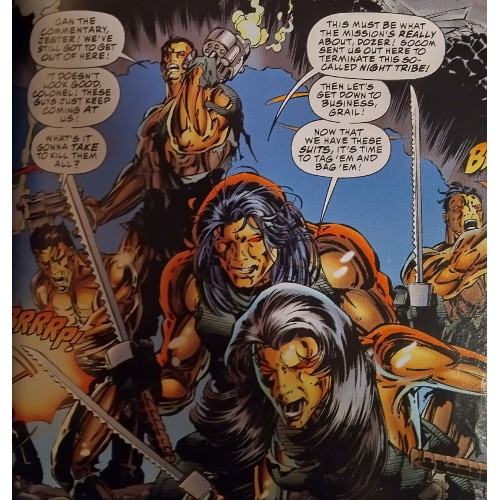
Like several of its four-color compatriots produced by Image at the time, Wetworks ends up being a blend of intriguing ideas–to specify, too many intriguing ideas–hampered by an inability to executing those concepts. The finished product (or as much as you can consider a "finished product" when evaluating three issues of a 43-issue series) is more coherent than, say, ShadowHawk or Cyberforce, but Wetworks: Rebirth remains a frustrating volume to contend with.
What's primarily tragic about these issues of Wetworks is the sheer amount of thought which went into it beforehand. Portacio, in an introduction, outlines the extent he and co-writer Brandon Choi plotted the series…it seems they had the entire storyline planned before ever writing down a word. It may be, then, my frustrations align with how little of that executed vision is collected here, not necessarily the vision itself. I'm reminded of a Daredevil volume written by Dennis O'Neil I reviewed a while back and how I felt whoever selected which issues to include poorly represented O'Neil's entire run. This volume is similar, and though including the first three issues of a series is more straightforward than cherry picking whatever issues you want to lump into a volume, it leaves us stranded. Image has not published other volumes collecting further issues. I couldn't tell you if I'd follow the series all the way through if they did, but I don't even have the option to choose whether or not I'd like to.
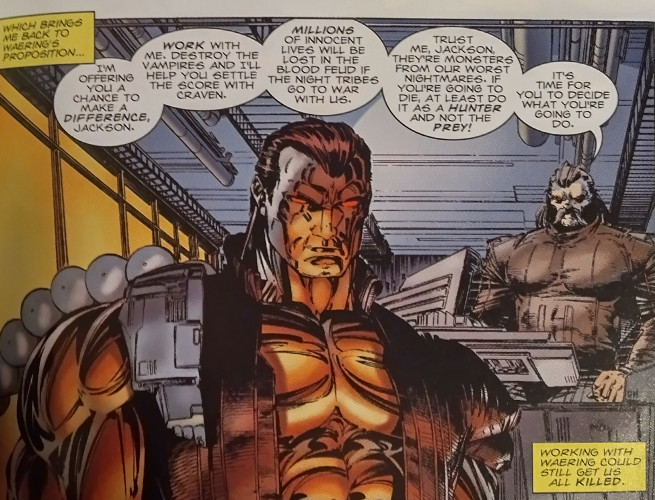
Written out, the overarching plot of Wetworks does feel more tightly plotted, though these first few issues represent a winding trail to reach Portacio and Choi's overarching conflict. Because Portacio and Choi know what the endgame is, they can afford to be coy about what they reveal initially. There are ways in which this works: we're quickly introduced to our central characters, a crack squad of military specialists who, unbeknownst to them, are on a suicide mission. When everything goes belly up, the group encounters golden "symbiotes" (no, not those symbiotes) which cover their skin with a second skin of protective armor and offer them new abilities.
Okay, maybe they're kinda like those symbiotes…
The concept, as its core, provides a wealth of tension. These soldiers are severed from their "masters," knowing they've been betrayed and seeking revenge with their newfound abilities while also protecting a frightened populace against conflict breaking out between "tribes" of vampires. Yes, you read that right: vampires. Oh, and werewolves pop up. Yeah, this is where things begin going off the rails.
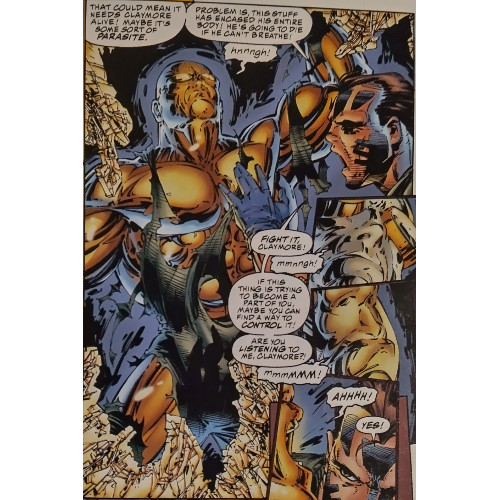
I like the angle of the team, knowing they've been abandoned by the superiors they took oaths to serve, scrambling and trying to find themselves in the wake of a disastrous mission. Unlike Youngblood, this group has no illusions about the system they previously served. Despite how such a betrayal could prove caustic to their own identities and mission, the team leaps into the saddle again, becoming embroiled in a fantastical war.
I wish Portacio and Choi had focused on this dynamic of the team, their personal struggles as a unit and as individuals, how they work together and distinctly. The opening chapter makes you believe these characters have history, they're familiar with each other. They trust each other, and by extension, the reader learns to trust how they work together. The symbiote angle only enhances those bonds, drenching them each in living golden armor and placing them in a superhuman situation that should unite them further. The shared circumstances, the unifying feeling of betrayal and redirecting their anger outward, should propel the comic forward.
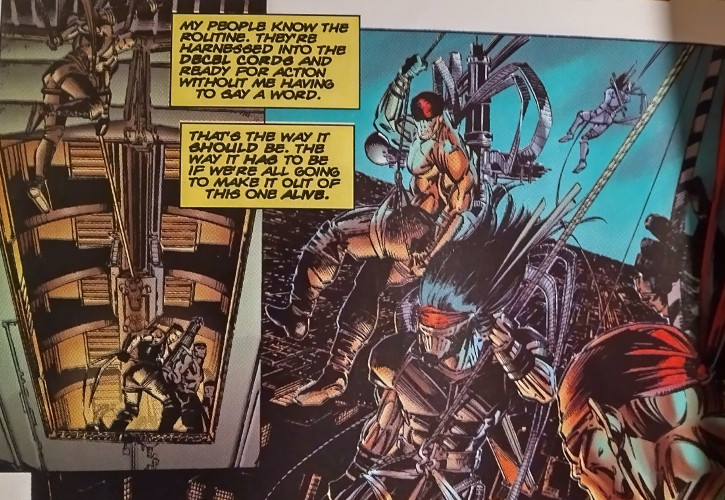
But then we get the vampires. And, after them, the werewolves. Written today, Wetworks would feel like a Twilight fanfic with some superhuman elements thrown in. Portacio and Choi endeavor to lace in deeper conflict from the vampires, envisioning a power struggle between members of royalty, hammering home how these blood-sucking misfits threaten the world. And were the series to stop at just the vampires, I may be able to cut it more slack. A team of biologically empowered supersoldiers against a bunch of fanged felons sounds like a heckuva time. But then the werewolves are thrown in as yet another faction we need to follow, and suddenly, these three issues are chock full of characters and conflicts, and the whole thing reads like a fantasy novel shoved into a short story.
The resulting battle scenes and bloodshed–and there is much, much bloodshed (this is an Image comic–scratch that, this is a comic published in the early 90s after all)–place our characters consistently in the midst of action. Snippets of dialogue reveal some personality traits about the individuals we're dealing with, but with character designs limited to "former soldier in army fatigues sporting a golden sheen," you become hard pressed to recognize, let alone identity with, any of our primary protagonists. Portacio and Choi encounter the same problem as other team books: the rapid fire introduction of characters buoyed by only the occasional dash of personality and problems make for shallow individuals to admire or want to follow. One guy has a nightmare we're told is recurring; another's body begins a secondary mutation thanks to the symbiote; a third character, a sniper, misses her mark, leading to brief suspicions of betrayal. But–and, again, this may be because I only have the first three issues–none of these ideas are explored in enough depth. Who cares about Colonel Dane's recurring nightmares if they linger in limbo? Who cares if Golden-Hued Man #5 undergoes a strange mutation if we're not offered the importance of why?

If Wetworks were focused on these personal issues rather than throwing us headlong into a series of world-building facts that expand the environment at a rapid rate, I would find I could care more. If you've already convinced me we've got a war going on between vampires and humans, don't blindside me with the inclusion of werewolves. Or, if you're going to include werewolves, provide me a solid narrative reason for doing so. "Oh, and there are werewolves, too," ends up distracting me rather than expanding my focus. I struggle about the war when I fail to care about the characters fighting the war
The werewolves and vampires are also indicative of another point: Wetworks is, oddly, enough, the title least tethered to the burgeoning Image Universe. Where Youngblood referenced Spawn, or Spawn and Savage Dragon popped up in Shadowhawk, or WildC.A.T.S. referenced a battle in Cyberforce (heck, even Pitt popped up for a bit in Cyberforce), we get no connections to any other early Image property in these issues. Digging a little into this, I found a "prequel" series where a member of Wetworks (Colonel Dane) belonged to a different military group alongside Grifter of WildC.A.T.S., but it appears those connections were not established conceptually when Wetworks began publication.
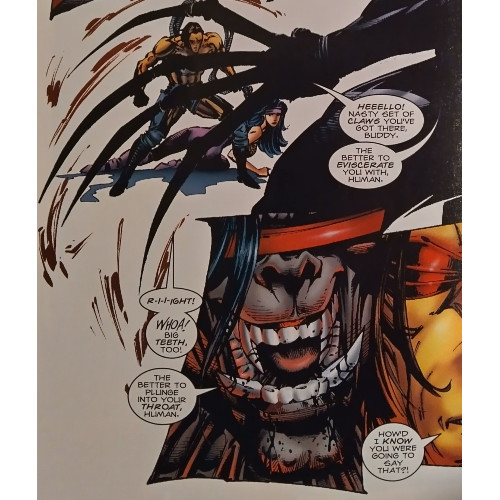
Despite their flaws, other titles at least gave a general sense of how they contributed to the growing Image Universe. Youngblood is a team of popular superheroes, Image's version of the Avengers in the vein of Mark Millar's Ultimates; Savage Dragon is an amnesiac alien working with the Chicago Police Department; Spawn is a resurrected mercenary seeking to understand why he was returned to life. You've got your superheroes, your aliens, your vigilantes, your mystical characters. Wetworks, along with Cyberforce and WildC.A.T.S., finds itself slotted into this somewhat nebulous "group of violent mercenaries poised to fight some form of injustice or evil" category. The characters in Wetworks are certainly more grounded, particularly when they're initially introduced, but they end up feeling just as faceless and empty as other members of other teams.
I've noted previously that early Image feels like early Marvel, with creators throwing whatever ideas they can at the wall. We're supposed to accept a universe where the vampires and werewolves in Wetworks coincide with the aliens in Savage Dragon, the demons in Spawn, the street level vigilantes in Shadowhawk, and other creatures and characters. Maybe it's due to Marvel's longevity, but I find the world of Image much less palatable. I believe this is because, given the references and cameos, that the early Image Universe was supposed to be, from the jump, a shared universe of characters and concepts, and yet we're given very little information as to how it all functions. The references are appreciated, the cameos are fun, but I want to know how a war between vampires and werewolves coincides with whatever sinister plots other villains are planning against the globe in other series. At this stage, Image hasn't constructed enough trust for me to fully believe the creators understood the inner workings of this world they were building. As I've noted previously, this could be because I have not allowed myself the chance to explore each series beyond a handful of issues, but if I cast myself in the role of a new reader back to 1992-93, when these books were beginning to get off the ground, I'd wager I'd struggle to remain a passenger on this particular plane. Think of the Wright Brothers attempting to assemble a modern day jet with their early 20th century technology and knowledge of aviation. Image, at this stage, feels similar to that.
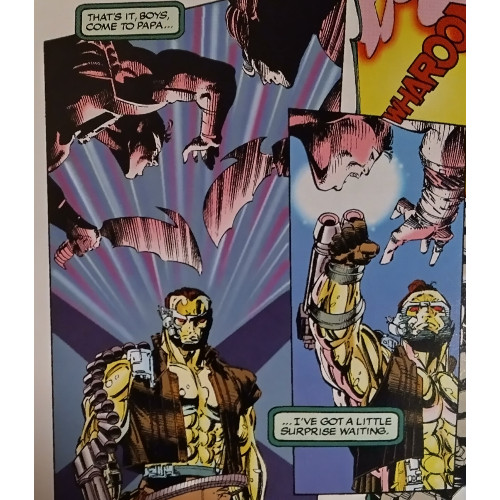
I guess that's as good a metaphor as any to leave us with as we wrap up this series of posts. It's been a heckuva journey, consisting of the scrambling online to procure these initial volumes, reading each collection, absorbing each story, tinkering with the words and photos. I saw this as an experiment, and as we reach the end, the experiment was a success. It boils down to what I was hoping to accomplish, and that hope was "read through and review the first volumes of each series started by the seven founding partners of Image Comics." If the parameters had been "read through and enjoy the first volumes, etc." this would have failed. These first issues aren't all that enjoyable, regardless of whatever cool concepts, swell story arcs, or insane ideas the creators cast upon the pages. The legacy of these series is important, and we should remember them for what they represent: seven men, stepping outside the bounds of corporate careers, to embrace their own creative ambitions.
The struggle is apparent: brilliant artists, several of these men are…good writers, most of them aren't. But even if Todd McFarlane couldn't write himself out of a paper bag, he made his vision for Spawn tangible, something he couldn't have done at Marvel. Erik Larsen published a character he'd refined for years. Whilce Portacio overcame the hardship of losing a loved one to get Wetworks developed. And each man retained creative control over their work, later deals with DC notwithstanding (looking at you, Jim Lee). So while I dug into the narratives and found them generally lacking, these blogs hopefully showcase something beyond the creative missteps: these men tried, they followed their ambitions, and even if the initial results are still disappointing, they crafted a foundation upon which a strong house of Image-inative ideas was constructed.